During a market corner, a buyer accumulates an asset with the intention of driving the price higher without any regard for its true value. Additionally, the buyer amasses such a large holding that market prices cannot remain elevated without continuous buying. For example, when the Hunt Brothers cornered the silver market, silver rose from $11 per ounce in September 1979 to nearly $50 an ounce in January 1980. Eventually, the Hunt Brothers stopped buying silver as they ran out of capital and the market for silver dried up. As happens with all market corners, when the buyer disappeared from the market, the price of silver spiraled downward. The Federal Reserve, knowingly or not, has cornered the credit market.
At the beginning of the credit crisis the Federal Reserve lowered short-term interest rates in an attempt to ease financial market strains. With the credit markets still not functioning properly, despite the Federal Funds rate being set in a range of 0 - 0.25%, the Federal Reserve devised a new plan to lower market interest rates for individuals and corporations. This plan, otherwise known as quantitative easing, called for the Federal Reserve to print money in order to buy bonds on the open market as well as guarantee investors from losses on other bonds.
Currently, the Federal Reserve is in the process of buying $1.25 trillion of agency mortgage-backed securities, $200 billion of agency debt, and nearly $300 billion of private credit (this excludes the $300 billion of Treasury purchases and also assumes that all buying programs are completed as stated by the Federal Reserve). To put this $1.75 trillion buying spree into perspective, PIMCO, the world's largest bond fund manager, managed $841 billion as of June 30, 2009. Essentially, the Federal Reserve has not only become a new bond market participant, but also will have grown to twice the size of the largest market participant in approximately one year. The entrance of such a large indiscriminate buyer helps to explain the rapid resurgence of credit markets.
The end of the Federal Reserve's credit market corner (assets that are cornered always collapse) could be sparked by a number catalysts. First, private investors may realize that bond prices are unjustifiably high and will sell them into the market faster than the Federal Reserve can buy them. Secondly, the Federal Reserve could slow its purchases, leading to lower marginal demand for bonds if not eliminating demand entirely. A third and more devastating outcome that could result from the Federal Reserve's quantitative easing would be a Dollar collapse.
Interestingly, on Wednesday, the Federal Reserve announced that it would slow its involvement in credit markets. Previously, the Federal Reserve was going to complete its $1.75 trillion program by December 2009, but now it has extended the program until March 2010. In doing so, the Federal Reserve has lowered its average purchases for the coming 3 months. This maneuver should prove problematic because the Federal Reserve's buying power has been paramount in reinflating the credit market bubble. While the Federal Reserve hopes that the recovering economy allows for moderate tightening, the real reason for altering the purchase program is the Dollar's continued decline and the Federal Reserve's fear of ending its purchases too abruptly.
The Federal Reserve's attempt to manipulate the credit market is a path to ruin. Although Ben Bernanke might believe that the recession and economic crisis are over, the Dollar's decline to new 2009 lows is a signal that an orchestrated market corner cannot succeed. As a result, the Federal Reserve's ability to continue its supportive endeavor is clearly being undermined. Despite the market corner appearing effective during the past six months with most asset prices having rallied, bond prices will one day begin to fall, and when they do, it will be clear that the market corner has failed.
















